My Balcony Gets No Sun in Fall: 7 Shade-Tolerant Plants You Can Still Grow in Pots
The crisp air and vibrant colors of autumn call many gardeners outdoors, but if your balcony faces north or sits under the constant shadow of a building, you might feel discouraged. You love the idea of creating a cozy fall display, yet direct sunlight is a luxury your space simply does not offer. This common challenge leaves many small-space gardeners wondering if fall planting is even possible. The good news is, a lack of direct sun does not mean your gardening days end when summer fades. You can absolutely cultivate a beautiful, thriving container garden on a shady balcony even as temperatures drop.
This article provides practical, actionable insights into transforming your low-light balcony into a charming fall retreat. You will discover how to select the right plants, master essential care techniques, and create stunning arrangements that thrive without direct sunlight. We focus on resilient, shade-loving plants that bring color and texture to your outdoor space, proving that even the shadiest spots can burst with life in autumn. Get ready to embrace the possibilities of fall gardening and enjoy your vibrant, low-maintenance balcony haven.
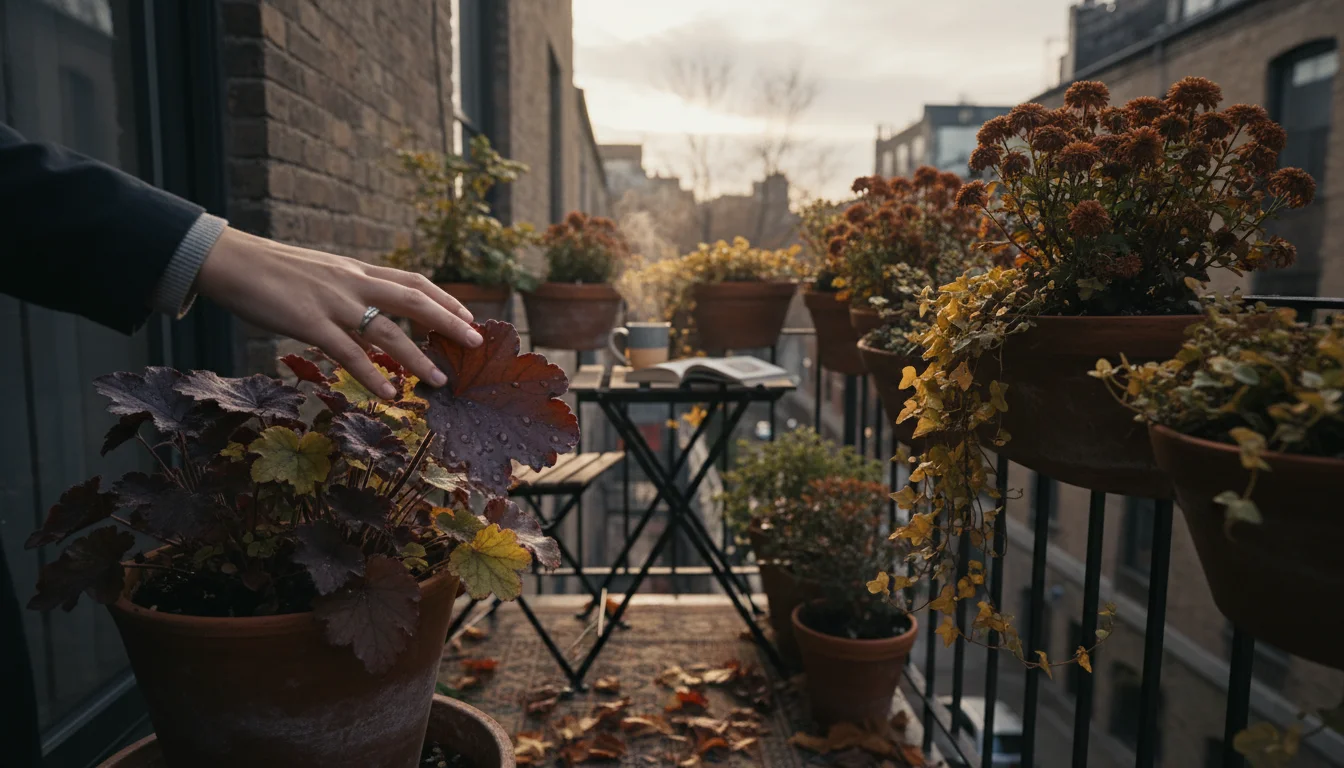
Understanding Your Shady Balcony: Light Conditions in Autumn
Before you choose a single plant, you must accurately assess the light your balcony receives. “No sun” rarely means absolute darkness. Instead, it typically falls into several categories of shade. Identifying your specific light conditions helps you select plants that will truly flourish. Your balcony’s light changes with the seasons, a crucial factor for fall gardening.
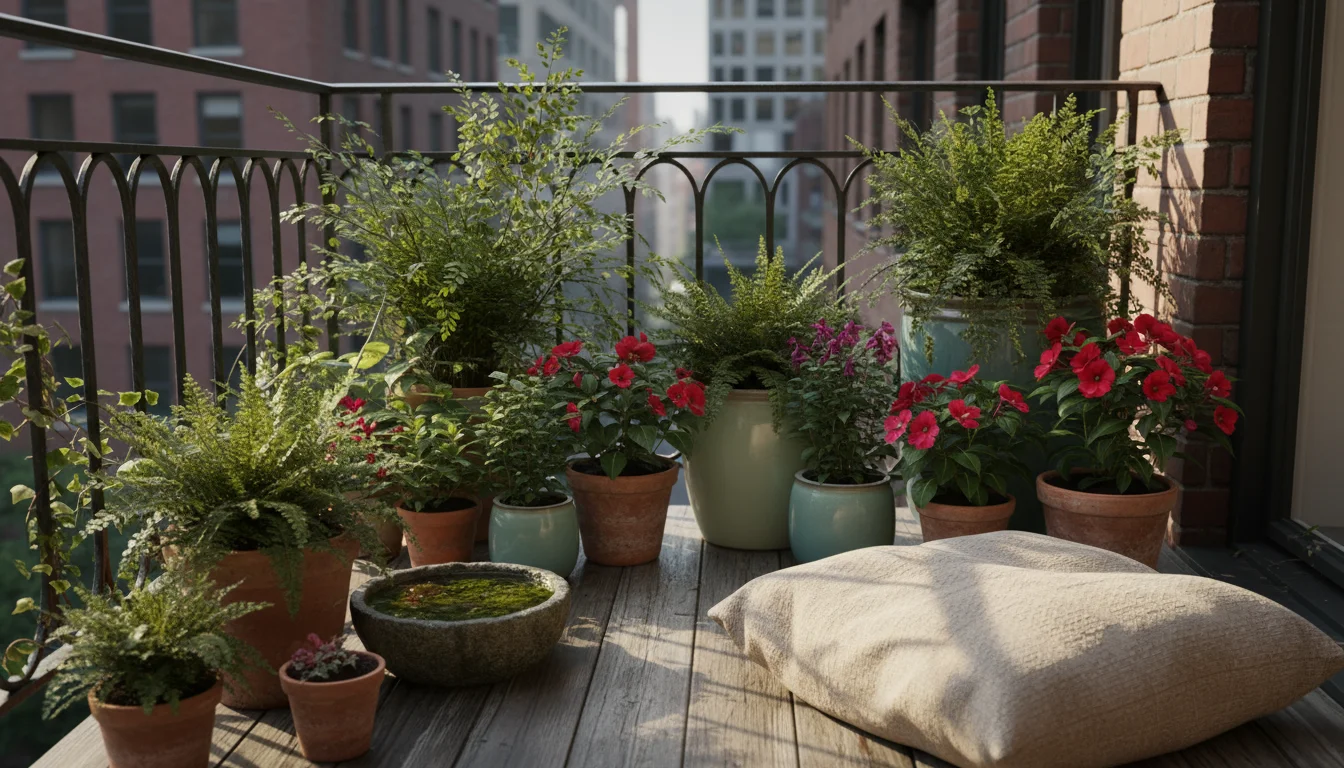
Defining Shade on Your Balcony
Understanding the nuances of shade is your first step to success:
- Deep Shade: This area receives virtually no direct sun and very little reflected light. It stays consistently dim throughout the day. Only the most tolerant plants will survive here.
- Partial Shade: This means your balcony receives 2 to 4 hours of direct sun, often in the early morning or late afternoon, with shade for the rest of the day. Many plants labeled “part-shade” thrive in these conditions.
- Full Shade: Areas in full shade receive less than 2 hours of direct sun per day, but they often get plenty of bright, indirect light. This is a common scenario for north-facing balconies or those overshadowed by tall buildings. Many “shade-loving” plants actually prefer full shade over deep shade.
- Dappled Shade: Filtered light, like that found under a deciduous tree, where sunlight is broken up by leaves. This provides gentle, intermittent light throughout the day. While less common on urban balconies, some spaces might experience this if adjacent to trees.
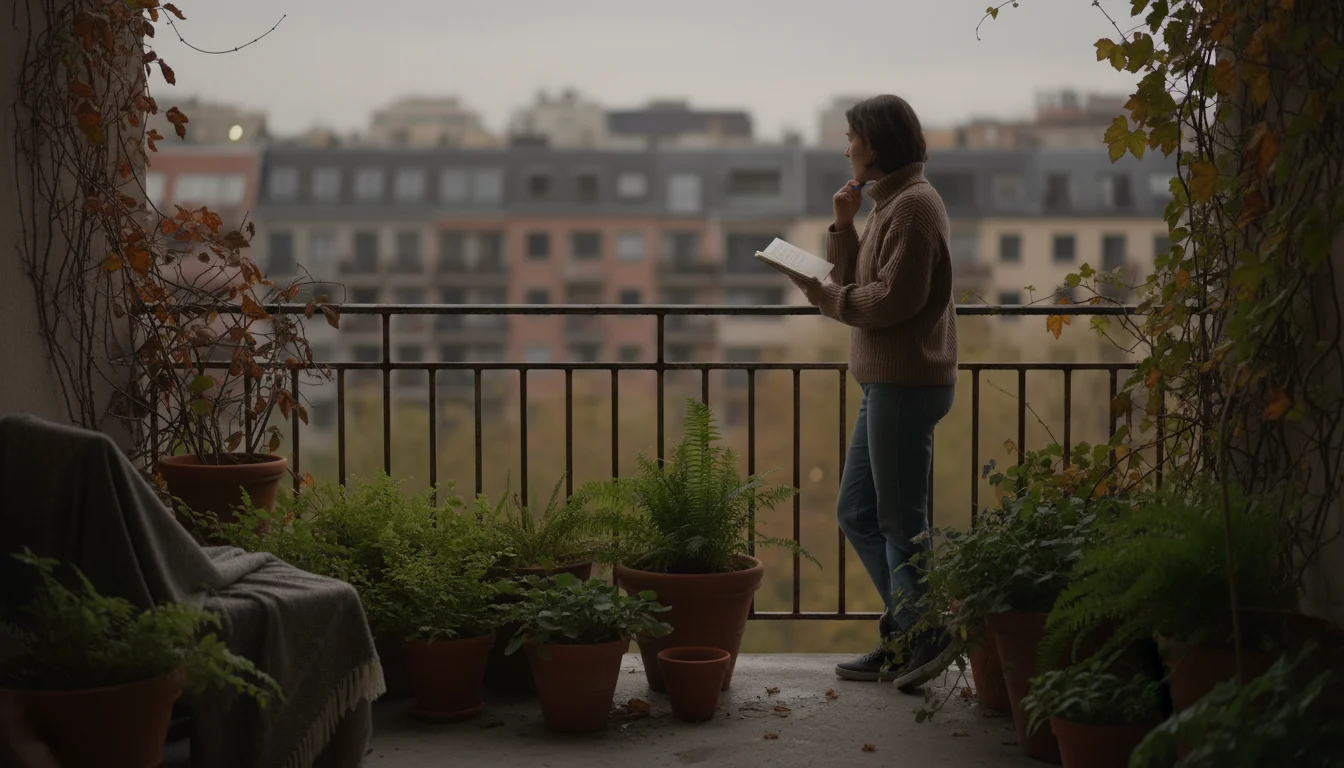
Why Fall Light Differs
The angle of the sun changes dramatically in autumn. In summer, the sun rides high in the sky, often casting light into spaces that become completely shaded by fall. As the Earth tilts, the sun’s path lowers, and days shorten. This reduction in both intensity and duration of sunlight means areas that might have received a few hours of sun in August could now be in perpetual shade by October. Observe your balcony for a full day over a week to accurately gauge its fall light. Note where the light hits, even if it is just reflected brightness, and for how long. This careful observation directly informs your plant choices.

Foundational Container Practices for Shady Spaces
Successful container gardening, especially in challenging low-light conditions, depends on a few core principles. These practices become even more critical when managing the cooler temperatures and reduced sunlight of autumn.

Choosing the Right Containers for Shade
Container selection impacts both plant health and aesthetic appeal. Size and material are key considerations:
- Size Matters: Plants in containers have limited root space. Larger pots hold more soil, which retains moisture and nutrients better, leading to healthier plants. For shade plants that often have shallower root systems or are relatively compact, a minimum 8-inch diameter pot works well, but larger is generally better for a fuller look and greater stability. Grouping several smaller pots can also create a lush effect.
- Material Choices:
- Terra Cotta: Porous, it allows soil to breathe and excess moisture to evaporate. This can be beneficial for plants prone to root rot, but it also means you will need to water more frequently. In fall, with cooler temperatures, this drying effect might be less pronounced but still present.
- Plastic: Lightweight and retains moisture efficiently. This makes plastic pots a good choice for shade, where evaporation is naturally slower. They are also budget-friendly and durable.
- Glazed Ceramic: Similar to plastic in moisture retention, glazed ceramic pots offer an elegant look. They can be heavy, so consider their placement carefully.
- Wood: Offers good insulation against temperature fluctuations. Ensure wooden containers are treated for outdoor use and have proper drainage.
- Drainage is Non-Negotiable: Every container absolutely must have drainage holes at the bottom. Without them, water collects, leading to soggy soil and root rot, a death sentence for most plants. If your chosen pot lacks holes, drill them yourself or use the pot as a cachepot, placing a plant in a smaller, drained nursery pot inside it. This allows you to remove the inner pot for watering and ensures water does not accumulate.
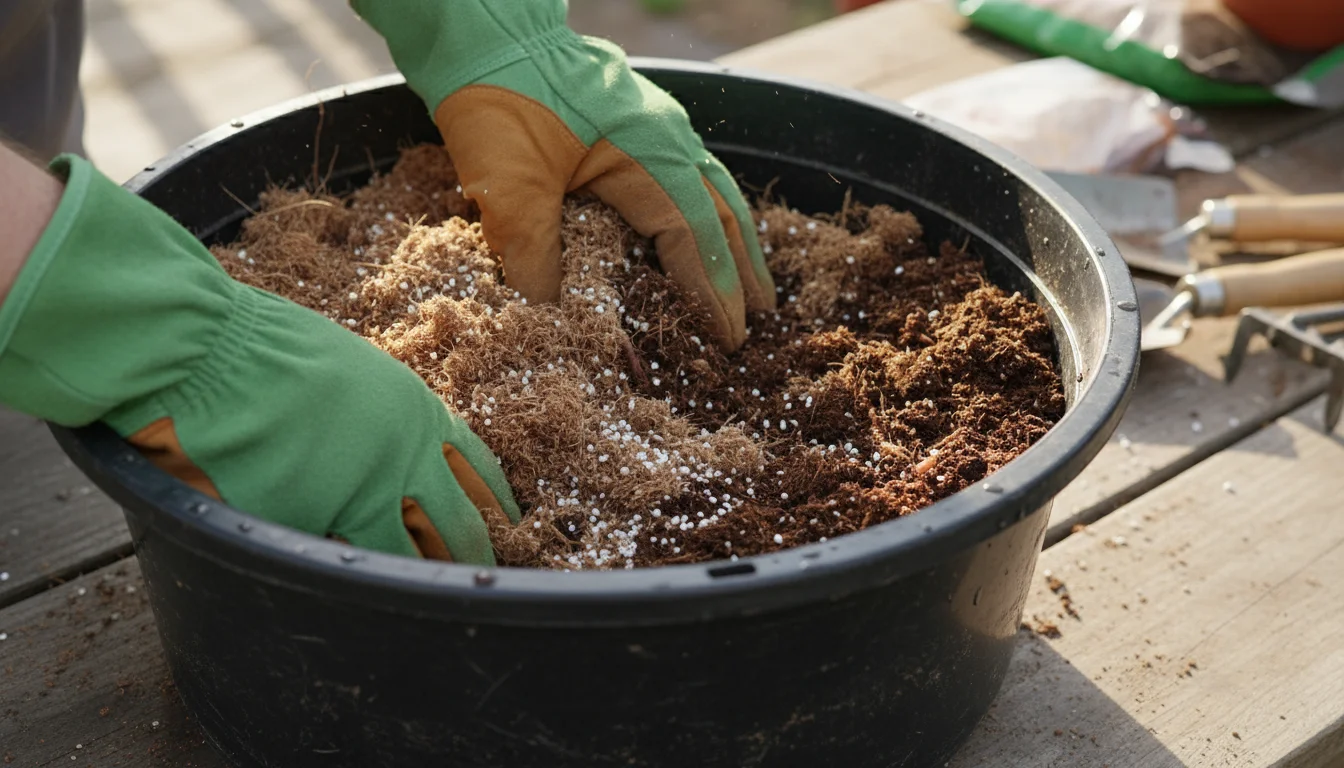
The Importance of Well-Draining Potting Mix
Garden soil is too dense for containers; it compacts easily and suffocates roots. You need a high-quality potting mix specifically designed for containers. This specialized blend provides the right balance of aeration, moisture retention, and drainage. Look for mixes that contain ingredients like perlite or vermiculite for drainage, peat moss or coir for moisture retention, and some compost for nutrients.
Good drainage means water moves through the soil easily, preventing waterlogging. In a shady, cool fall environment, soil dries out much slower than in direct sun. A well-draining mix prevents root diseases by not allowing roots to sit in constantly saturated conditions. Some gardeners add an extra handful of perlite or horticultural grit to their potting mix for shade containers to further enhance drainage and aeration, especially if they tend to overwater or if their climate is particularly damp in autumn.

Watering Wisely in Fall Shade
Your watering habits need to adapt to the season and your light conditions. In shade, soil dries out significantly slower than in sun. Overwatering is a primary killer of container plants, especially in fall.
- Feel the Soil: The best method is to stick your finger about 2 inches deep into the soil. If it feels dry, it is time to water. If it feels damp, wait.
- Deep, Infrequent Watering: When you do water, do so thoroughly until water drains from the bottom of the pot. This encourages deep root growth. Avoid frequent, shallow watering, which leads to weak surface roots.
- Morning Watering: Water in the morning to allow any excess moisture to evaporate throughout the day. This helps prevent fungal issues that can arise from prolonged dampness, particularly in cool, shady conditions.
- Reduce Frequency as Temperatures Drop: As fall progresses and temperatures continue to fall, plant metabolism slows, and they require even less water. Adjust your watering schedule accordingly.
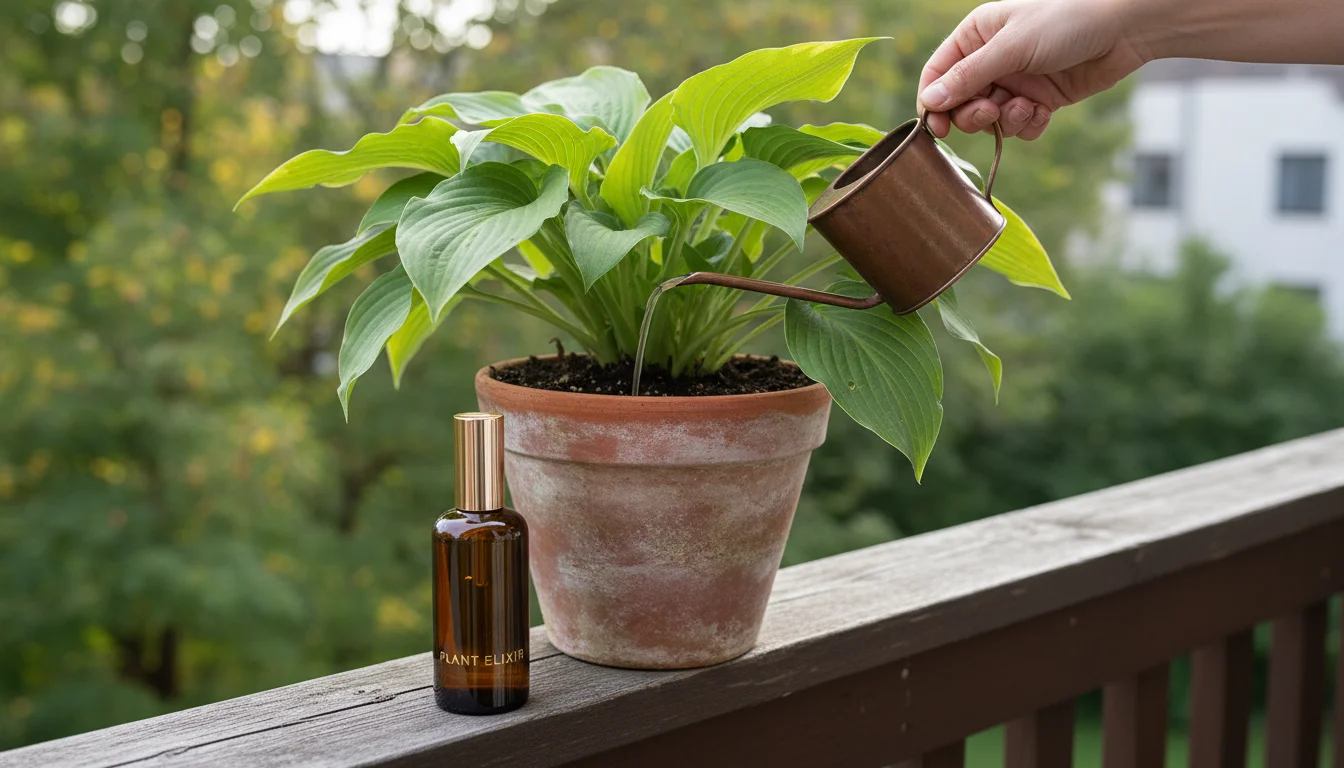
Fertilizing Considerations for Autumn
Most fall-planted annuals or new perennial plantings will not require significant fertilization. Plants are preparing for dormancy, not active growth. If you are using a fresh potting mix, it often contains slow-release fertilizers that provide enough nutrients for the initial weeks. For established perennials, a light, balanced liquid feed at half strength once a month in early fall might be beneficial, but cease fertilization entirely once temperatures consistently drop below 50°F (10°C) to avoid stimulating new growth that would be vulnerable to frost. Focus on healthy soil and appropriate watering over heavy feeding during autumn.
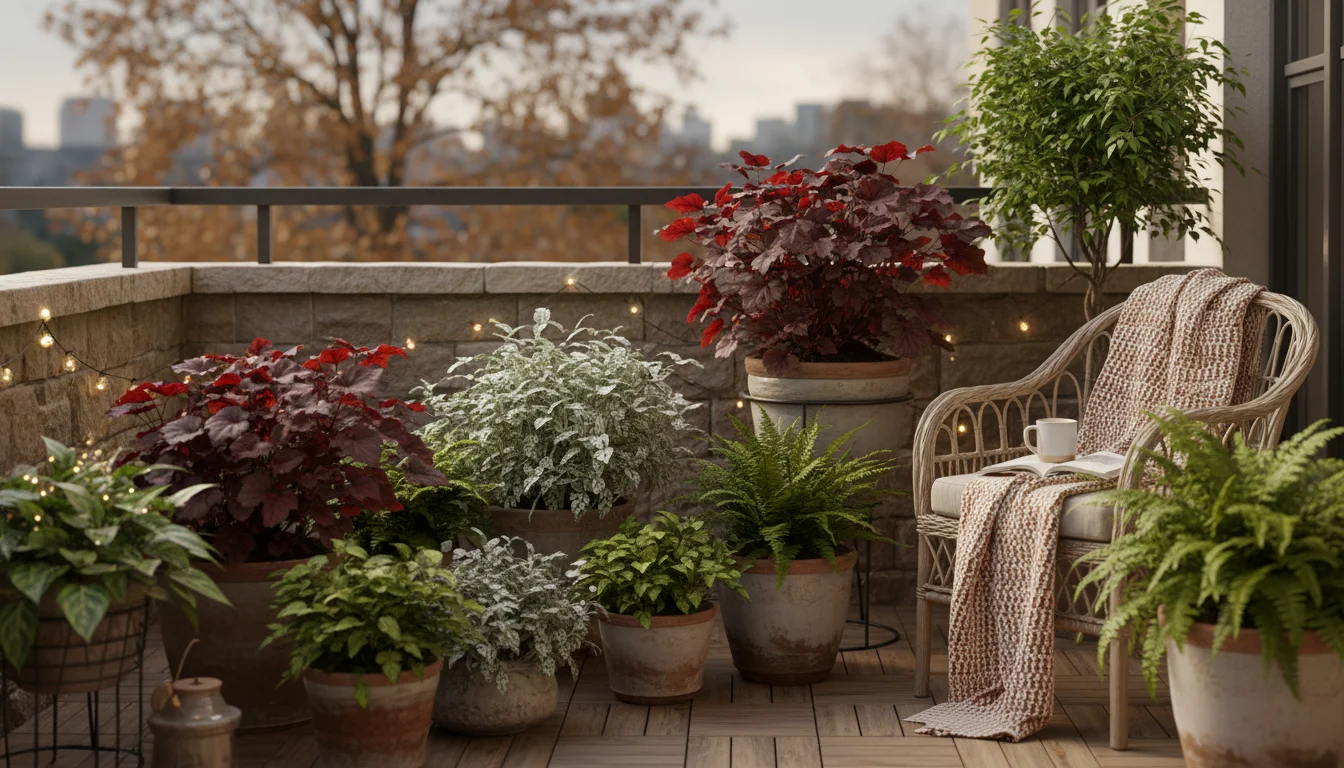
Spotlight on Shade-Tolerant Fall Plants: Our Top 7 Picks
Creating a vibrant fall display on a shady balcony involves selecting plants that not only tolerate low light but also offer rich textures and colors suitable for the autumn palette. These seven plants excel in containers and will bring life to your low-light space.
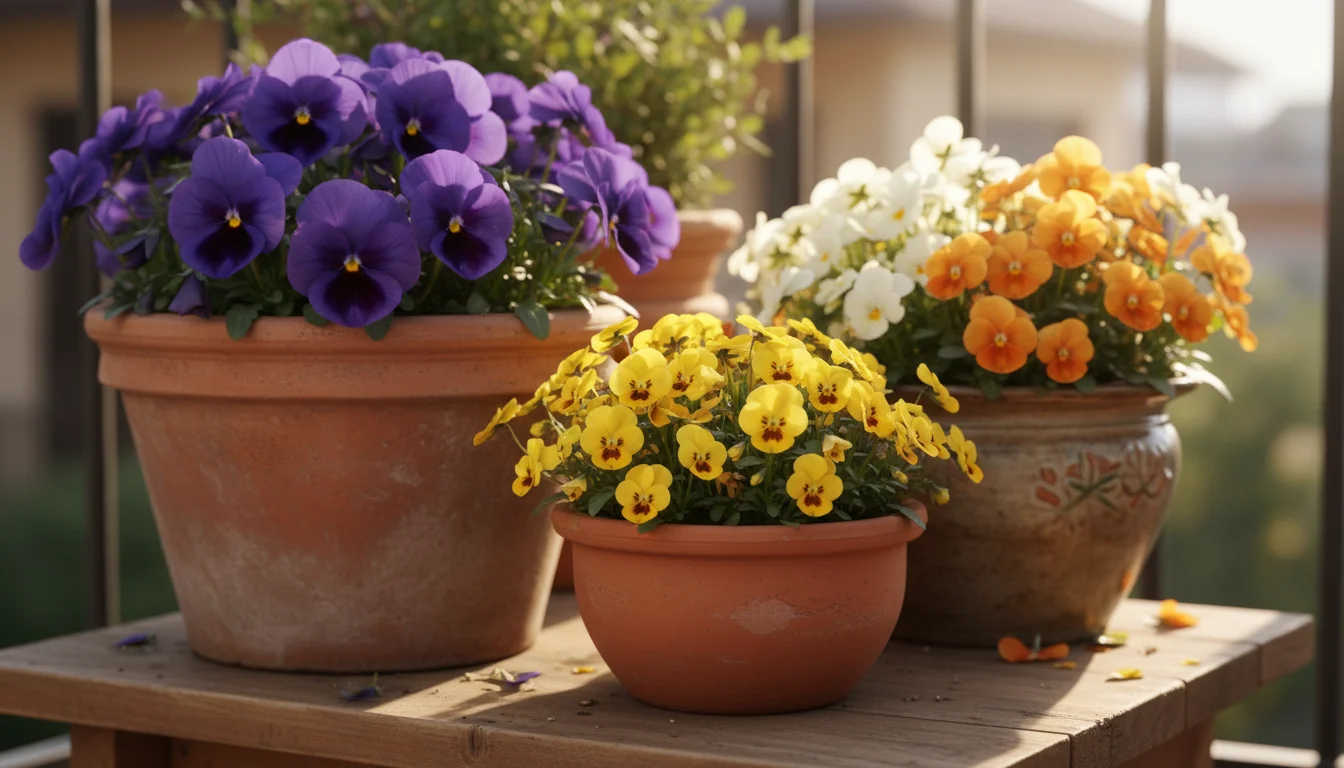
1. Pansies and Violas (Viola x wittrockiana & Viola cornuta)
These cheerful annuals are fall gardening champions. Pansies offer larger, often brightly colored blooms, while violas have smaller but more numerous flowers, both in a stunning array of purples, yellows, whites, and oranges. They thrive in the cool temperatures of fall and can even tolerate light frosts, often continuing to bloom well into early winter in many climates. They perform beautifully in partial to full shade, especially where they receive bright indirect light. Too much warmth or deep shade can make them leggy, so aim for that bright, indirect sweet spot.
- Light: Partial shade to full shade (bright indirect light is ideal).
- Water: Keep soil consistently moist, but not waterlogged. Allow the top inch of soil to dry before watering again.
- Soil: Well-draining potting mix, rich in organic matter.
- Container Suitability: Excellent for filling in containers, window boxes, or as edgers. Their compact size makes them perfect for small pots or as “filler” plants.
- Fall Interest: Continuous blooms, available in a wide range of autumnal colors.

2. Heuchera (Coral Bells)
Heuchera is a superstar for shade, admired more for its incredible foliage than its delicate flower spikes. Available in a breathtaking array of colors, from lime green, deep purple, and bronze to silver and nearly black, their ruffled or smooth leaves provide fantastic texture and year-round interest in many zones. Most varieties prefer partial to full shade; too much sun can scorch their leaves, especially the lighter-colored cultivars. They are perennials, meaning they can return year after year, making them a sustainable choice for your balcony.
- Light: Partial to full shade. Brighter shade often intensifies leaf color.
- Water: Consistent moisture, but ensure good drainage. Tolerates slight drying between waterings once established.
- Soil: Rich, well-draining potting mix.
- Container Suitability: Excellent as a “filler” or “thriller” depending on variety and size. Their mounding habit works well in various container designs.
- Fall Interest: Vibrant, often intensified foliage colors, providing long-lasting visual appeal.
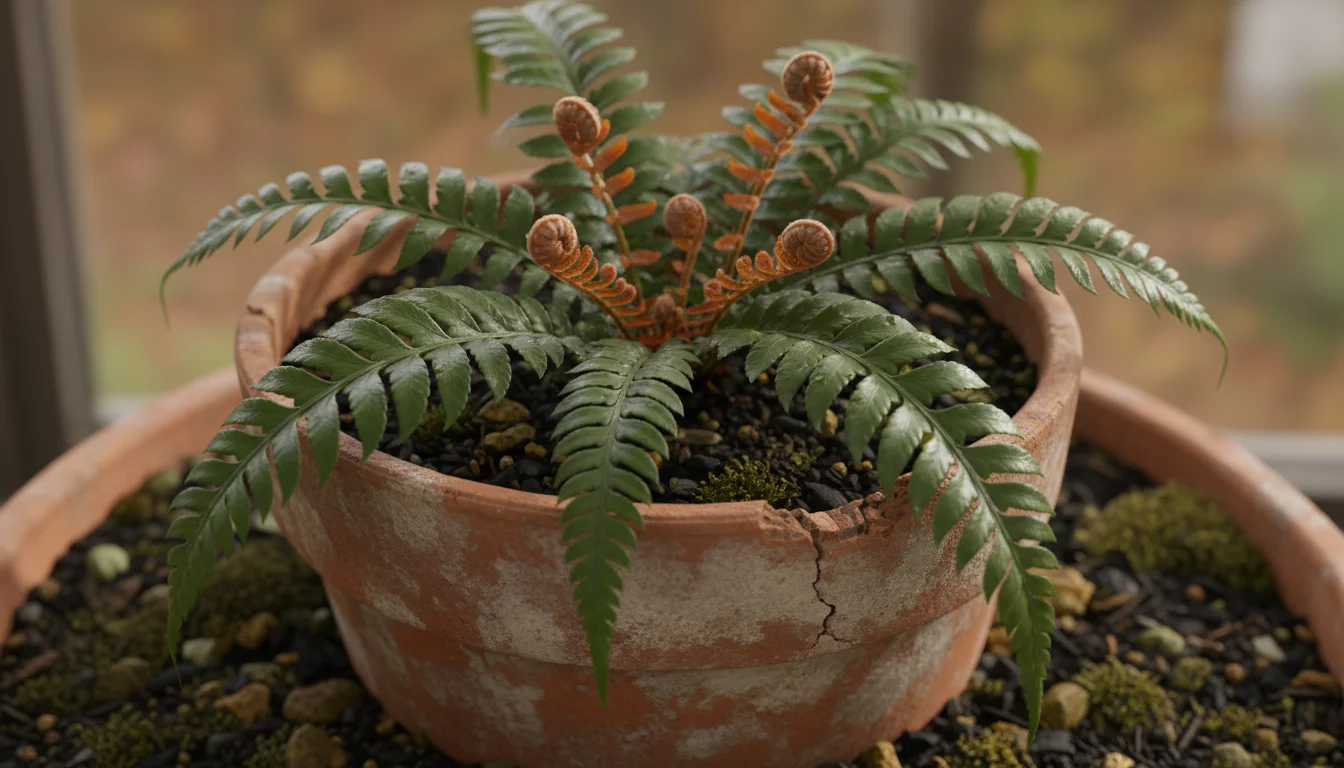
3. Autumn Fern (Dryopteris erythrosora)
Many ferns are natural shade dwellers, and the Autumn Fern stands out for its unique seasonal interest. Its new fronds emerge a coppery-red or bronze color in spring and fall, maturing to a glossy dark green in summer. This vibrant fall coloration makes it a perfect choice for adding warmth to a shady autumn display. Its delicate, lacy texture contrasts beautifully with broad-leaved plants. It is also an evergreen or semi-evergreen perennial, offering continued interest through winter in milder climates.
- Light: Partial to deep shade. Protect from direct sun, which can scorch fronds.
- Water: Prefers consistently moist soil. Do not allow it to dry out completely.
- Soil: Humus-rich, well-draining, slightly acidic potting mix.
- Container Suitability: A fantastic “filler” or “thriller” for adding fine texture and a naturalistic feel.
- Fall Interest: Distinctive coppery-red new growth adds unique seasonal color.
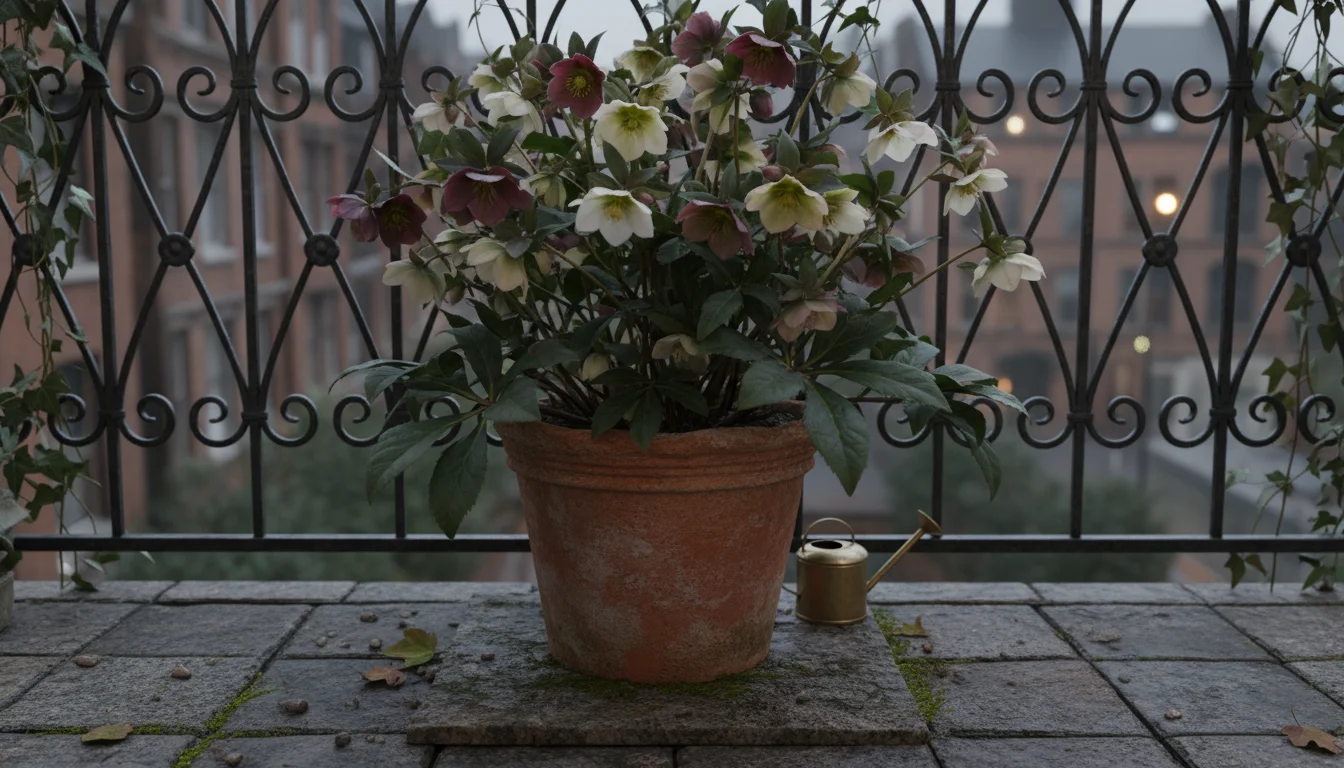
4. Hellebores (Helleborus orientalis, Lenten Rose)
Hellebores are remarkable for their ability to bloom in late winter or early spring, bringing color when little else does. Many varieties develop attractive foliage that remains evergreen, making them valuable container plants even before their blooms appear. While their peak bloom is typically later, their robust, leathery foliage adds a substantial, deep green anchor to fall containers. They are incredibly shade-tolerant and long-lived perennials, providing a sophisticated presence.
- Light: Partial to deep shade.
- Water: Keep consistently moist but well-drained. They do not like soggy feet.
- Soil: Rich, well-draining potting mix with plenty of organic matter.
- Container Suitability: Excellent as a centerpiece “thriller” or a sturdy “filler” due to their strong foliage.
- Fall Interest: Robust, attractive evergreen foliage, providing structure and texture.
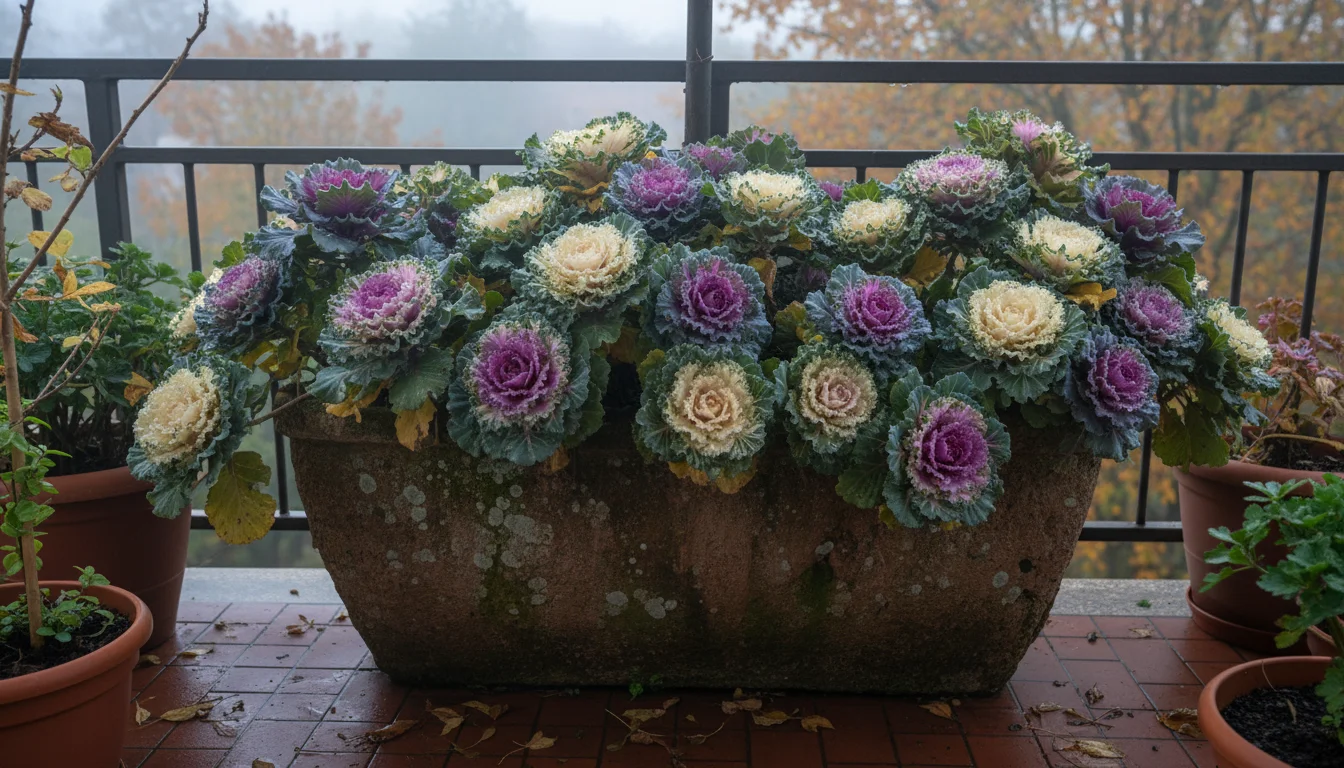
5. Ornamental Kale and Cabbage (Brassica oleracea)
These striking plants are grown for their dramatic, often frilly or ruffled foliage that intensifies in color with cooler temperatures. As autumn deepens, their centers transform into brilliant shades of white, pink, purple, and red. Ornamental kale and cabbage are annuals that thrive in partial sun to partial shade, making them perfect for those slightly brighter shade spots on your balcony. They are incredibly tolerant of cold, handling light frosts with grace, making them ideal for long-lasting fall displays.
- Light: Partial sun to partial shade. Colors deepen with cooler temperatures and some light.
- Water: Keep soil consistently moist.
- Soil: Well-draining, fertile potting mix.
- Container Suitability: Excellent “thriller” or “filler” with bold, textural impact. Pair with smaller plants around their base.
- Fall Interest: Stunning, intensifying foliage colors as temperatures drop.
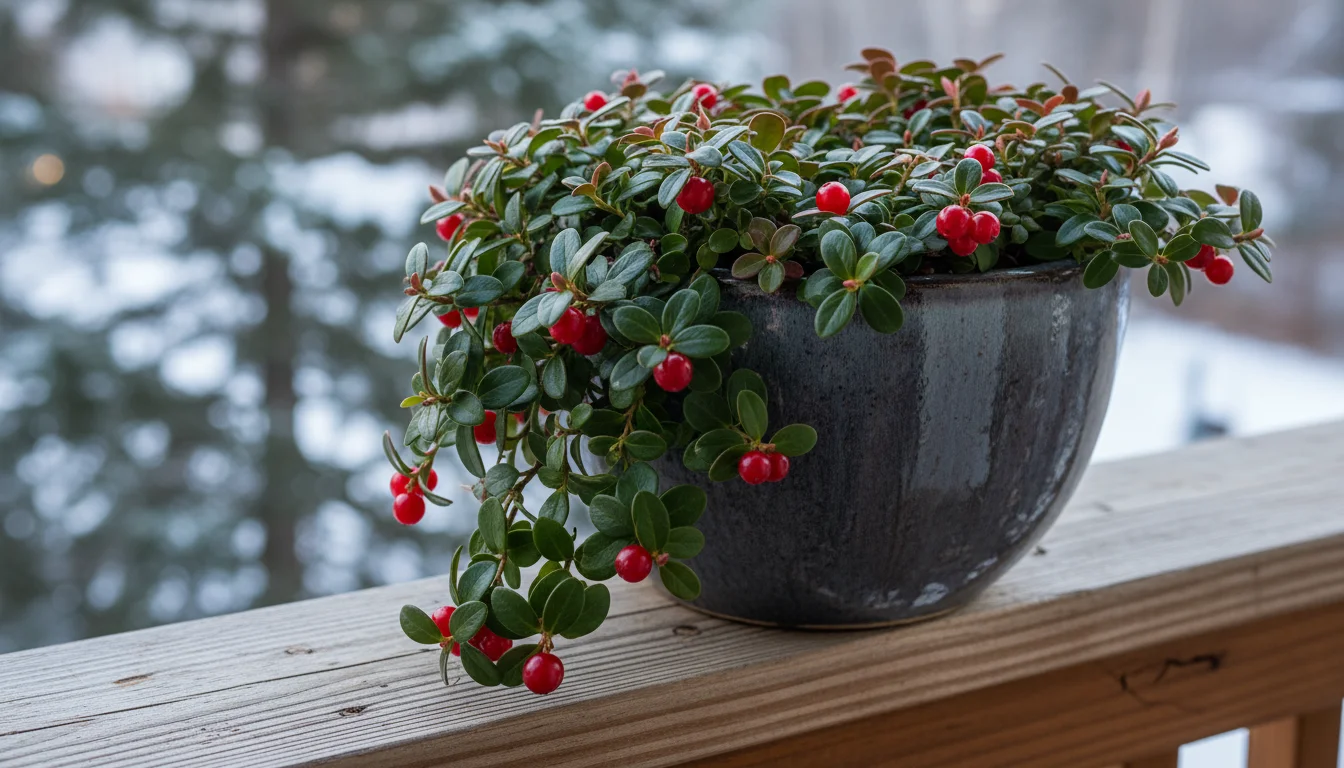
6. Wintergreen (Gaultheria procumbens)
Wintergreen is a delightful native evergreen groundcover that excels in shady containers. It features glossy, dark green leaves that often develop a reddish tinge in colder weather. Small, bell-shaped white flowers give way to bright red, edible berries that persist through fall and winter, offering a fantastic splash of color. It is a slow-growing plant that remains compact, making it perfectly suited for small pots or as a “spiller” at the edge of a larger container. It prefers acidic soil, so ensure your potting mix reflects this need.
- Light: Partial to full shade.
- Water: Keep consistently moist; does not tolerate drought.
- Soil: Acidic, humus-rich, well-draining potting mix. Consider a rhododendron/azalea mix.
- Container Suitability: Excellent “spiller” or small “filler” due to its low-growing, spreading habit.
- Fall Interest: Evergreen foliage, persistent bright red berries, and often a reddish leaf tint in fall.

7. Ivy (Hedera helix, English Ivy and cultivars)
Ivy is a classic, versatile choice for shade. Its trailing habit makes it an excellent “spiller” for containers, softening edges and providing year-round green or variegated foliage. Many cultivars offer different leaf shapes and patterns, from deep green to speckled white and green. Ivy tolerates a wide range of light conditions, from bright shade to deep shade, and is incredibly resilient to cool temperatures. It is a vigorous grower, so you may need to trim it back to keep it tidy within your container arrangement.
- Light: Partial to deep shade.
- Water: Keep soil moderately moist; tolerates some drying between waterings.
- Soil: Well-draining, general-purpose potting mix.
- Container Suitability: Unbeatable as a “spiller,” creating a graceful cascading effect over the edge of pots.
- Fall Interest: Evergreen foliage, providing consistent texture and color.

Designing Stunning Fall Container Arrangements for Low Light
Creating eye-catching container arrangements in the shade requires a slightly different approach than designing for sunny spots. Without the vibrant blooms that full sun encourages, you focus on texture, foliage color, and interesting forms. The classic “Thriller, Filler, Spiller” method still applies, but your plant choices and emphasis shift.
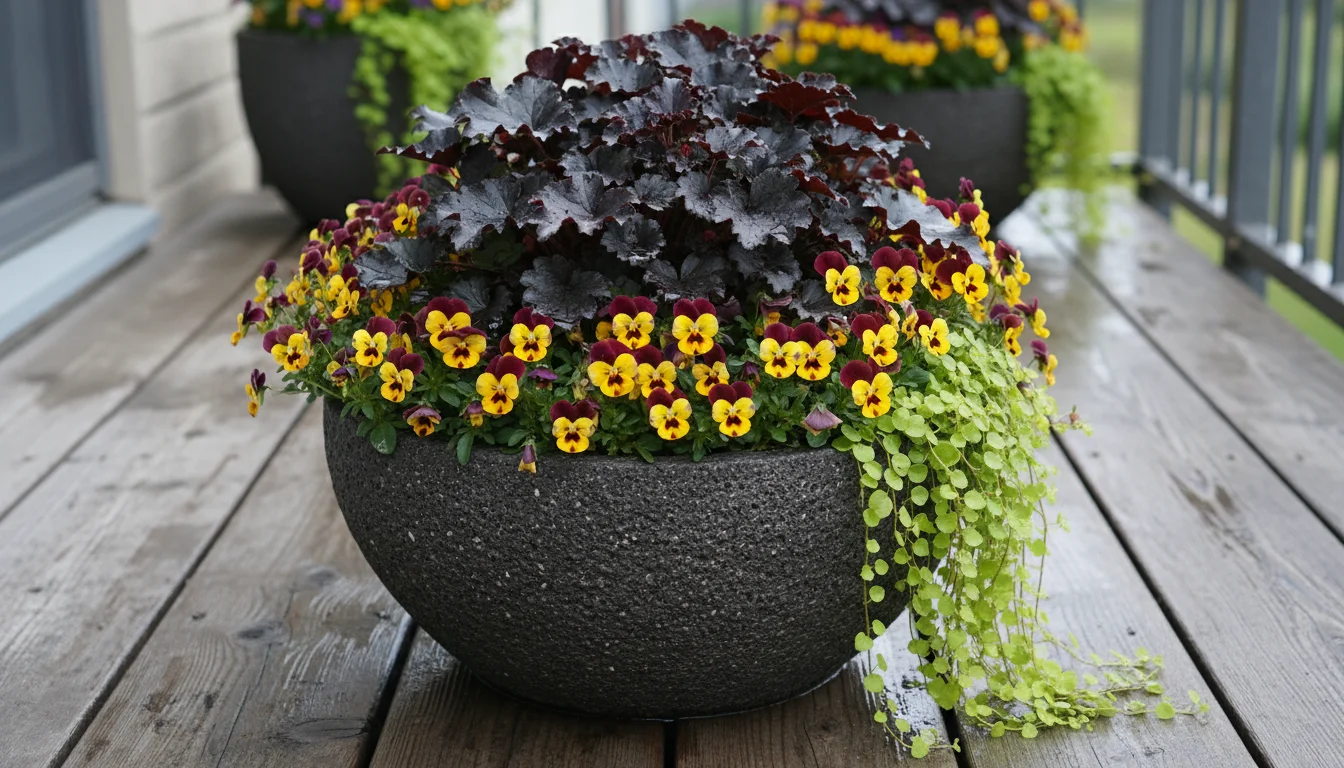
The Thriller, Filler, Spiller Method for Shade
This design principle helps create balanced, appealing containers:
- Thriller: This is your focal point plant. In shade, your thriller might be a Heuchera with dramatic dark foliage, a tall fern like a Japanese Painted Fern (if you can find one that fits the shade requirements) or the architectural form of Ornamental Kale. Choose a plant with height and visual interest. Place it in the center or slightly off-center for visual balance.
- Filler: These plants surround the thriller, adding mass and volume. Think about contrasting textures and colors. Pansies and Violas are excellent for a splash of color, while smaller Heuchera varieties, compact ferns, or even small Hellebores can provide lush foliage. Aim for plants that create a mounding effect.
- Spiller: These plants trail over the edge of the container, softening its hard lines and adding a graceful flow. Ivy is the quintessential shade spiller, with its various leaf forms and variegation. Wintergreen also works beautifully as a low-growing spiller with its red berries.
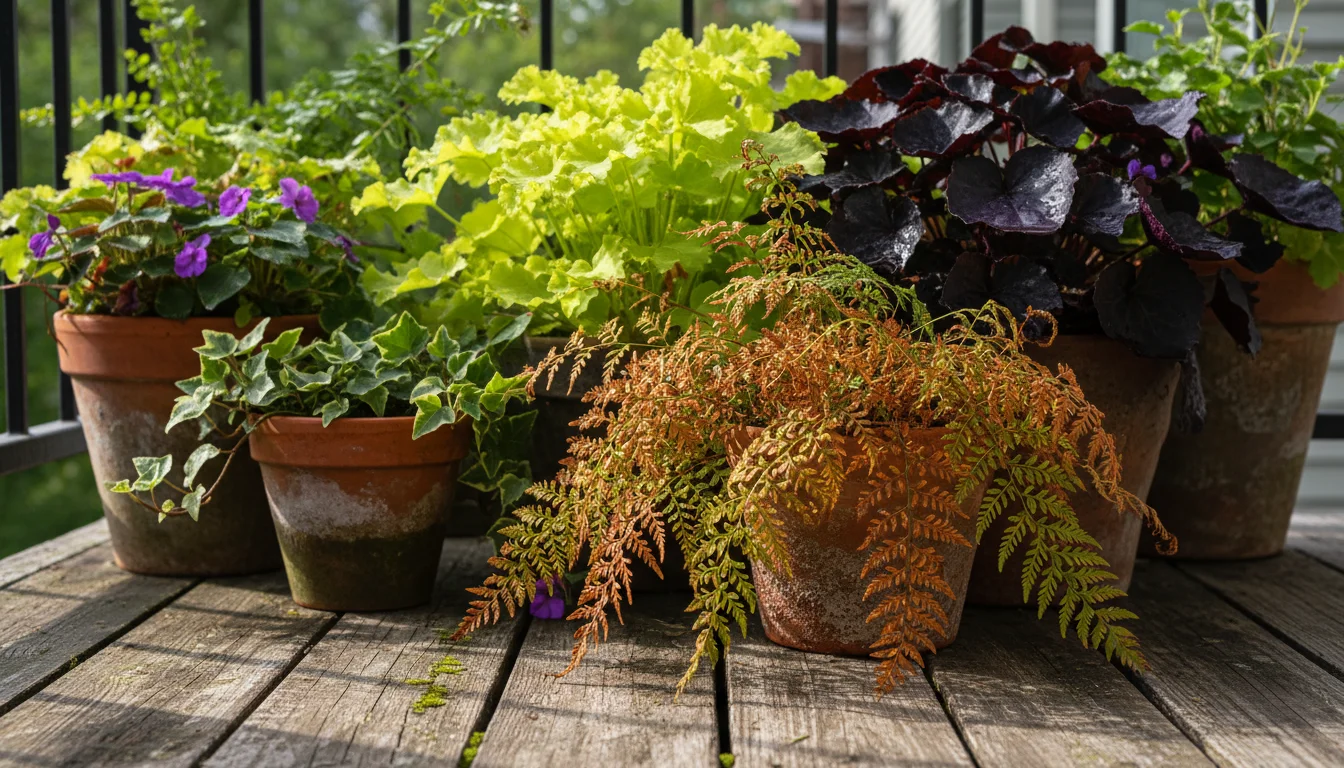
Emphasizing Texture and Foliage Color
Since flowering might be less abundant or intense in low light, foliage becomes your primary design tool. Combine plants with different leaf shapes, sizes, and colors:
- Contrast Textures: Pair the delicate, lacy fronds of an Autumn Fern with the broad, bold leaves of Ornamental Kale or the ruffled texture of a Heuchera. This interplay adds depth and interest.
- Layer Colors: Utilize the incredible spectrum of Heuchera foliage, from deep purples to lime greens and coppery reds. Combine these with the dark green of ivy or the bright flowers of violas. Even subtle variations in green foliage can create a rich tapestry in a shady spot. Consider the fall transformation of plants like Wintergreen, whose berries and reddish leaves add seasonal warmth.
- Vary Heights: Introduce plants of different heights to create visual movement. A taller thriller, surrounded by mounding fillers, with cascading spillers, creates a dynamic and engaging display.

Grouping Containers for Greater Impact
On a small balcony, a single pot might look lonely. Grouping containers of varying sizes and heights creates a more substantial and visually impactful display. This technique also allows you to experiment with different plant combinations in individual pots, then arrange them as a cohesive unit. For example, a tall container with an Ornamental Kale thriller could be flanked by a medium pot featuring Heuchera and a small pot with Pansies and Ivy spilling over. Use crates, inverted pots, or small plant stands to add verticality to your grouping.

Adding Non-Plant Elements for Seasonal Charm
Integrate decorative elements to enhance your fall theme. Small pumpkins, gourds, pinecones, dried seed pods, or decorative branches can be nestled among your plants or placed alongside your containers. These elements provide additional texture and color, reinforcing the autumn aesthetic without needing extra light. As Thanksgiving approaches, you can easily swap out elements to transition your display for the upcoming holidays, maintaining visual appeal throughout the season.
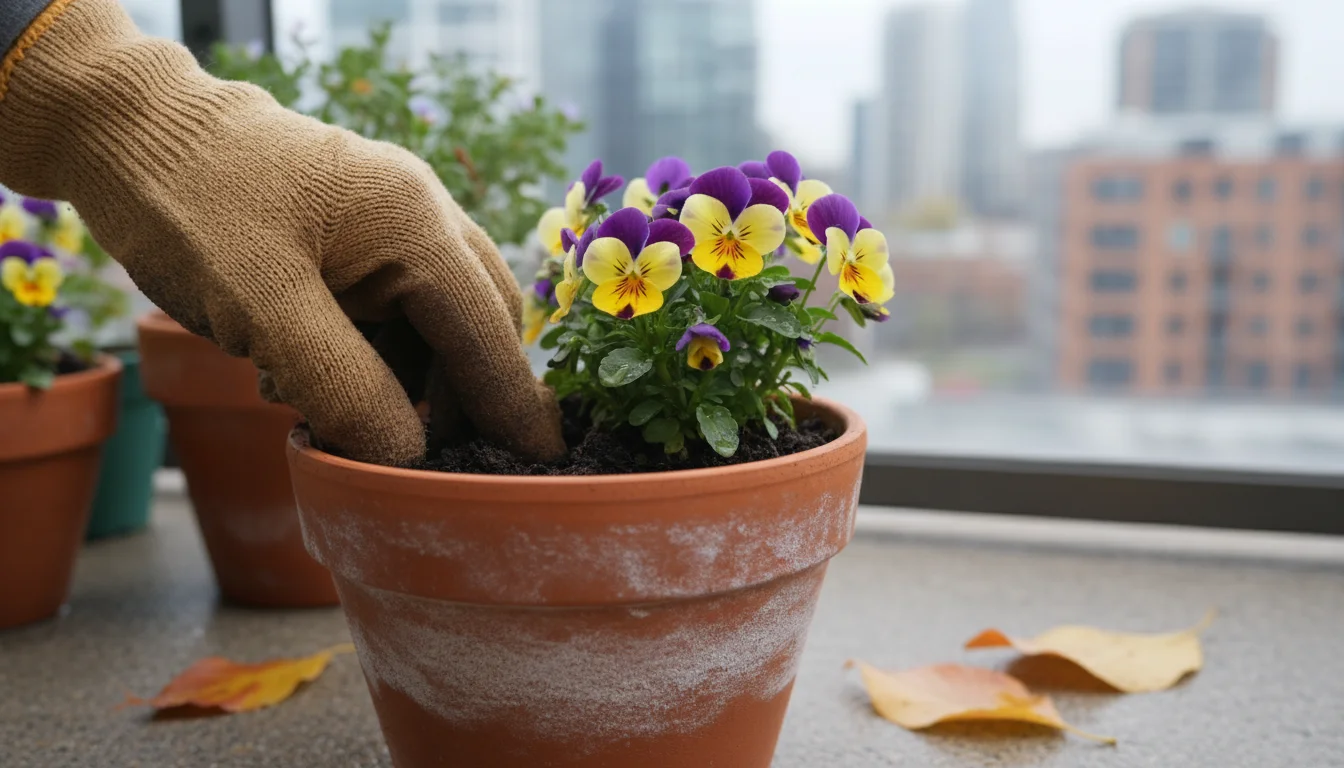
Caring for Your Fall Containers Through Changing Seasons
Your beautiful fall container garden requires specific care as autumn progresses and potentially transitions into winter. Understanding how to maintain plant health and prepare for colder temperatures ensures your display lasts as long as possible.
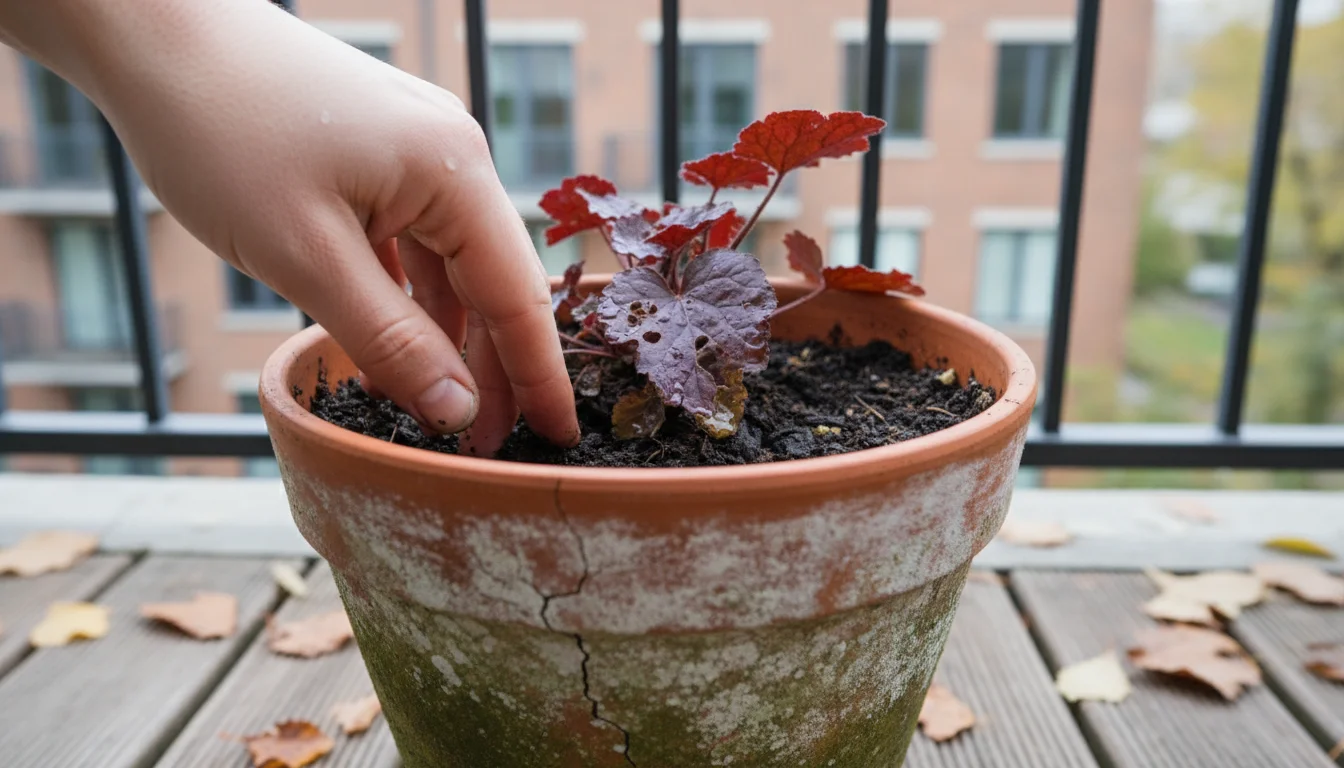
Adjusting Watering as Temperatures Drop
As discussed earlier, cool, shady conditions significantly slow down soil drying. Continue to check the soil moisture regularly, but anticipate watering much less frequently than in summer. Overwatering leads to root rot, a particular risk in cool, damp fall conditions. Err on the side of underwatering rather than overwatering. If you notice yellowing leaves, it often indicates too much moisture rather than too little in a shady environment. Ensure excellent drainage remains paramount.
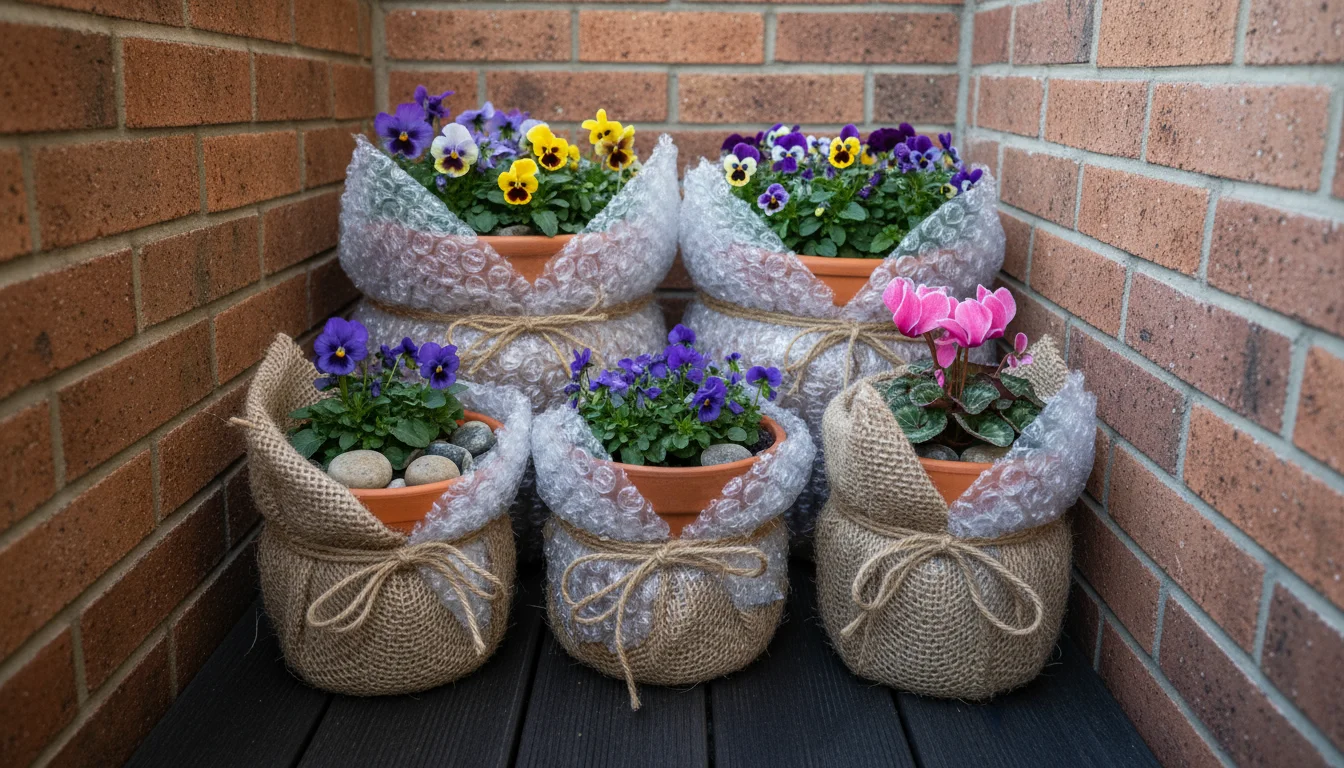
Frost Protection and Overwintering Strategies
Even shade-tolerant plants have limits when it comes to cold. Knowing your local hardiness zone helps, but balcony conditions can be colder due to exposure to wind. When frost warnings arrive, take action:
- Move Indoors Temporarily: For annuals like Pansies and Violas, or tender perennials like Cyclamen, simply bringing the pots indoors overnight into a garage, shed, or even a sheltered corner of your balcony can provide enough protection from a light frost. Return them outdoors during the day.
- Insulate Pots: For larger, heavier pots, you might not be able to move them. Wrap pots in burlap, bubble wrap, or old blankets to insulate the roots from extreme cold. Placing containers close to the building wall also offers some protection from chilling winds.
- Consider Perennials: If you have planted perennials like Heuchera, Hellebores, or Autumn Ferns, they are generally hardy to colder temperatures. However, in containers, their roots are more exposed than if planted in the ground. Mulching the top of the soil with shredded leaves or straw provides an insulating layer.
- Bringing Indoors for Winter: Some hardy perennials, especially if they are borderline hardy for your zone in a container, can be brought indoors for winter. Find a cool, dimly lit spot (like a basement or unheated room) where they can go dormant, requiring minimal water. Move them back out in spring. Ivy can also be brought indoors as a houseplant for the winter.
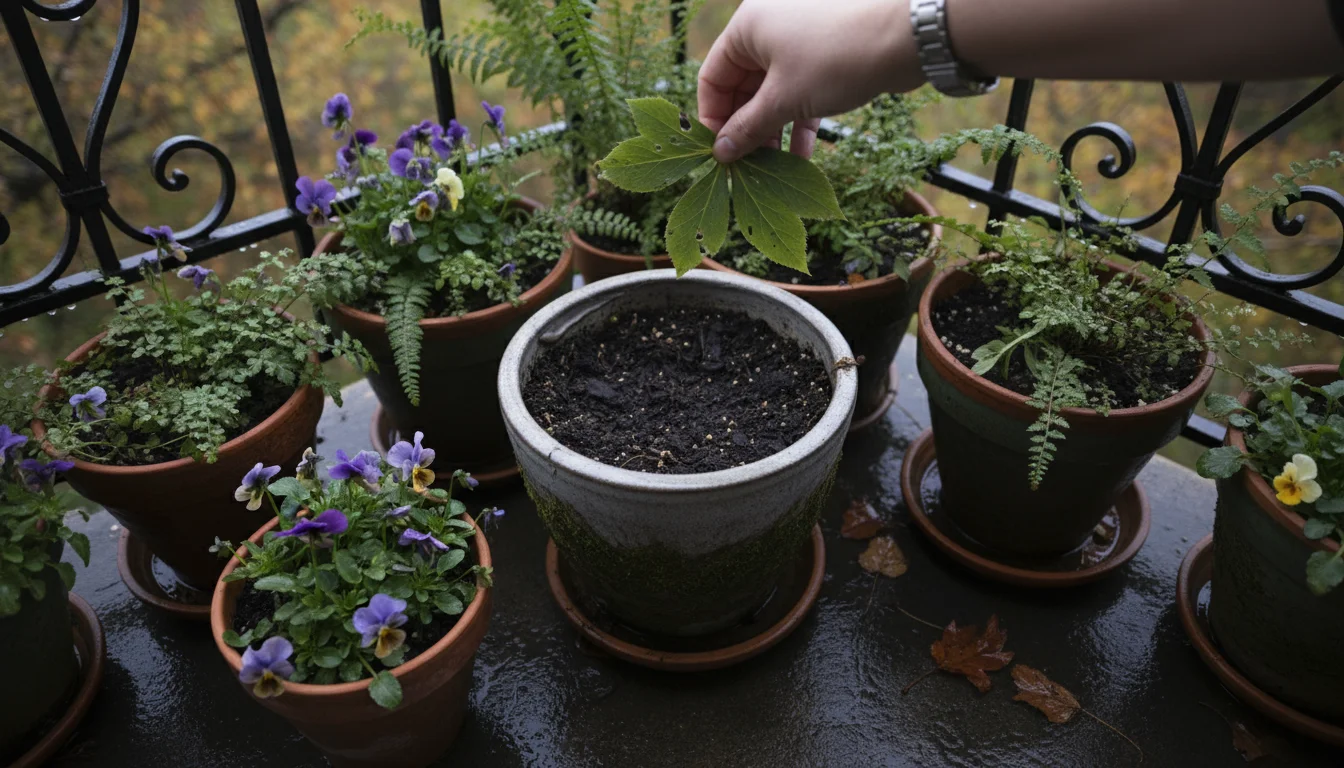
Pest and Disease Management in Fall
Cooler weather generally reduces pest pressure, but some issues can still arise. Slugs and snails might become more active in damp, shady conditions, munching on tender leaves of plants like Pansies or Hellebores. Inspect your plants regularly. Remove slugs by hand or use organic slug baits. Fungus gnats, though mostly harmless to plants, can be annoying indoors if you bring plants in. Allow the top layer of soil to dry out between waterings to deter them.
Fungal diseases like powdery mildew can appear, especially in humid, shady spots with poor air circulation. Ensure good spacing between plants. If you see white powdery spots, remove affected leaves and improve air circulation. Healthy, well-cared-for plants are generally more resistant to pests and diseases.
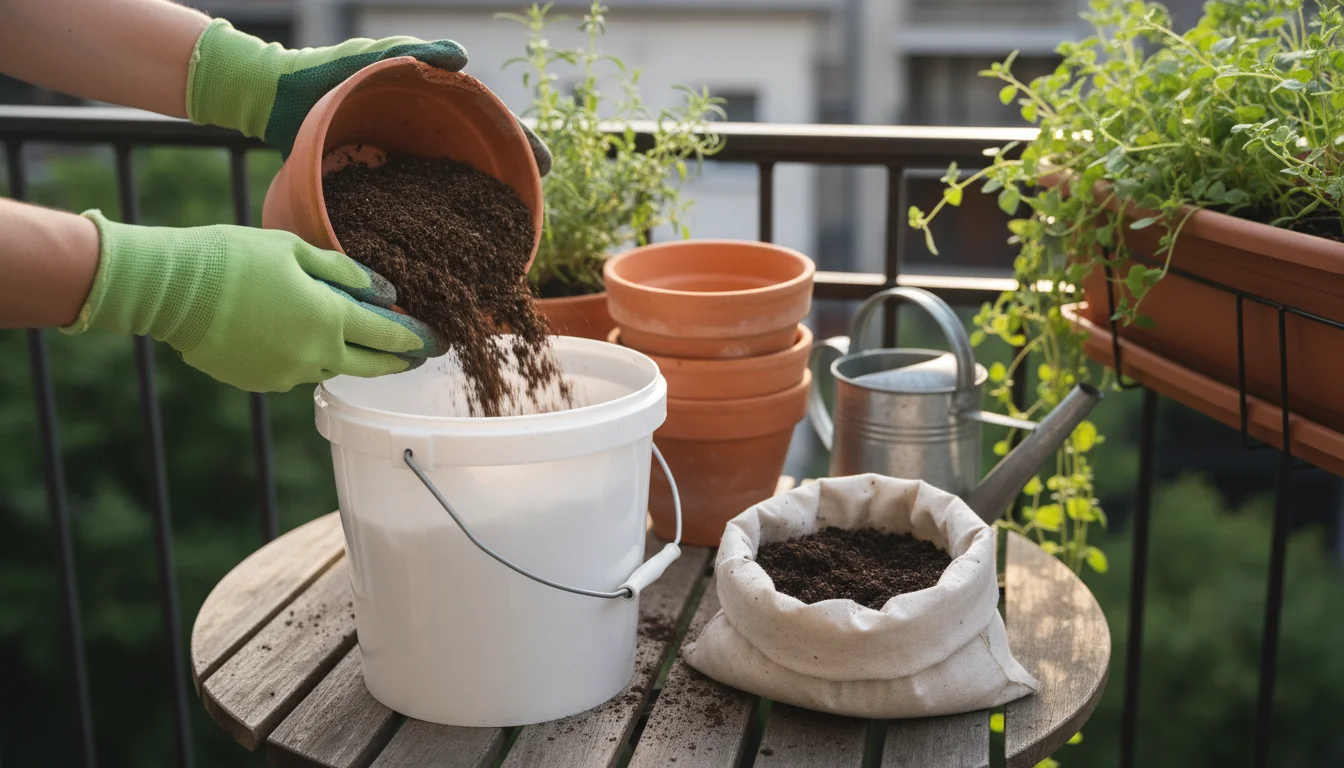
Embracing Eco-Friendly Practices
Sustainable gardening extends to your fall containers:
- Composting: As annuals fade, instead of discarding them, add their non-diseased parts to a compost bin if you have one. This enriches soil for future plantings.
- Reusing Potting Mix: For annuals, you can often reuse much of the potting mix the following season, especially if you amend it with fresh compost and a little new potting soil to replenish nutrients and structure. Sterilizing old soil is rarely necessary unless plants had a significant pest or disease issue.
- Water Conservation: Precise watering in fall helps conserve water. Using saucers under pots can catch excess water for plants to absorb, but remember to empty them if they remain full for more than an hour or two to prevent waterlogging.
- Native Plants: Where suitable, incorporating native shade-tolerant plants like Wintergreen can support local ecosystems and often requires less intervention due to their adaptation to local conditions.
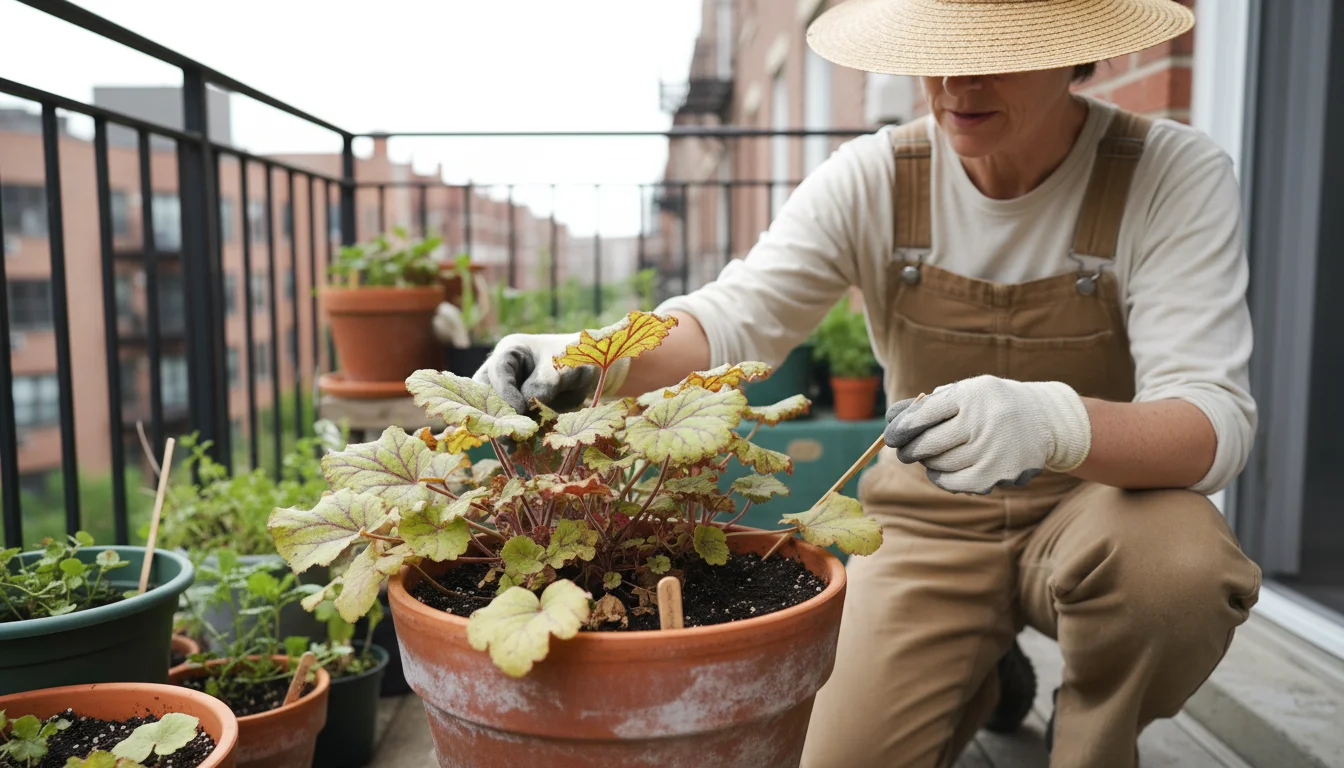
Troubleshooting Common Challenges in Fall Shade Gardens
Even with careful planning, you might encounter issues in your fall shade garden. Knowing how to diagnose and address these common problems helps ensure your plants remain healthy and vibrant.
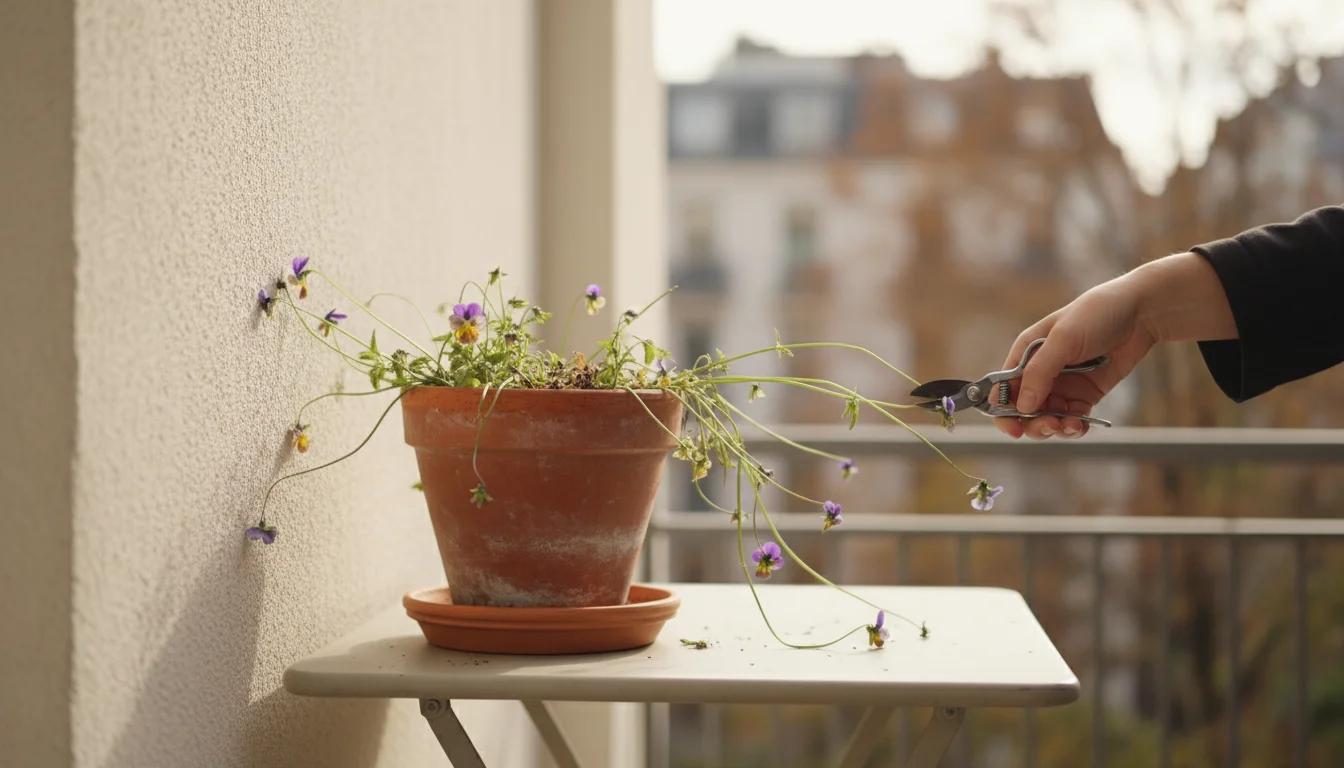
Leggy Growth
If your plants become stretched, spindly, and sparse, with long stems and few leaves or flowers, they are typically “leggy.” This is usually a sign of insufficient light. While some leggy growth is natural as plants stretch for light, excessive legginess indicates a problem. For shade-tolerant plants, it means they are not getting enough *bright* indirect light. Pansies and Violas, for instance, might stretch in deep shade.
- Solution: Assess your balcony’s light. Can you move the plant to a spot with more reflected light, such as closer to a light-colored wall or railing? Prune back leggy stems to encourage bushier growth, though be aware that new growth will also stretch if light conditions do not improve. For annuals, sometimes replacing a plant with one better suited to very deep shade is the most practical solution.

Yellowing Leaves
Yellowing leaves on lower parts of the plant often signal a watering issue, particularly overwatering in cool, shady conditions. When roots sit in waterlogged soil, they cannot take up oxygen and nutrients, leading to chlorosis (yellowing).
- Solution: Check soil moisture deeply before watering. Allow the top 2-3 inches of soil to dry out. Ensure your pots have adequate drainage holes. If soil remains consistently wet, you might need to repot with a more porous, well-draining potting mix. If yellowing is accompanied by brown, crispy edges, it could indicate underwatering, which is less common in fall shade but still possible.

Lack of Bloom or Fading Color
If your flowering plants, like Pansies or Violas, are not blooming as profusely or their colors seem dull, it could be due to several factors. While they are shade-tolerant, they still need *some* light to produce flowers. Insufficient light results in fewer blooms. For ornamental foliage plants like Kale or Heuchera, fading colors can also be a sign of inadequate light or lack of cold exposure.
- Solution: Increase light exposure if possible. Rotate pots regularly to ensure all sides of the plant receive light. Ensure plants receive enough nutrients; a light feeding with a balanced liquid fertilizer in early fall can encourage blooming, but stop when temperatures drop consistently. For ornamental Kale, cooler temperatures actually enhance color, so a warm fall might delay their vibrant display.
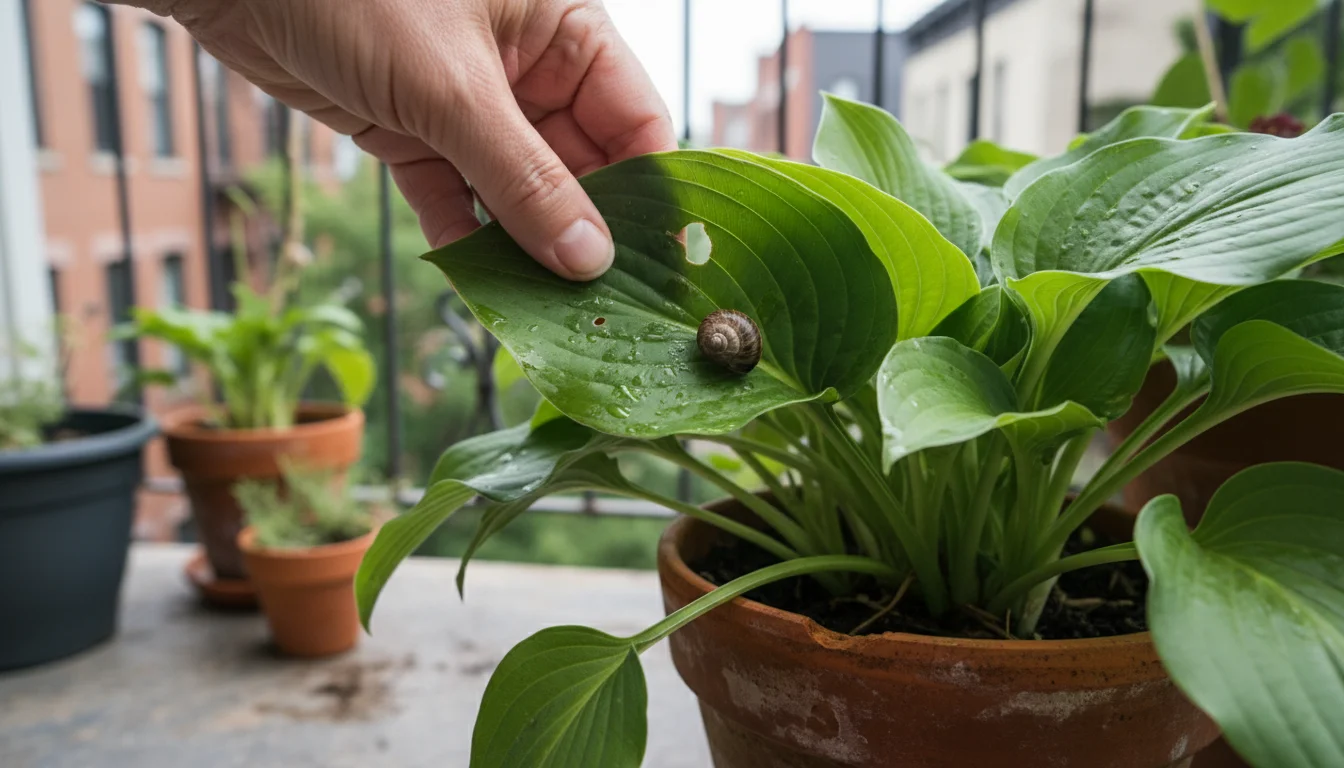
Pests and Diseases
Even in fall, pests can be a nuisance. Slugs and snails thrive in damp, shady conditions, leaving ragged holes in leaves. Fungus gnats might appear in overly wet soil. Fungal spots or powdery mildew can occur in humid, poorly ventilated areas.
- Solution: Regularly inspect your plants, especially the undersides of leaves. Hand-pick slugs and snails or use organic baits. For fungus gnats, allow soil to dry out completely between waterings. Improve air circulation around plants by spacing them out. For fungal issues, remove affected leaves, avoid overhead watering, and consider an organic fungicide if the problem persists. Healthy plants with proper air circulation are your best defense.
For trustworthy gardening information, visit:
Clemson University Extension — Home & Garden, Colorado State University Extension — Gardening, North Carolina State Extension — Gardening and Virginia Cooperative Extension — Lawn & Garden. These organizations provide expert, research-based advice for gardeners at all levels.
Your shaded balcony can still be a green oasis with the right plants! Frequently Asked Questions
Can I really grow anything on a north-facing balcony?
Absolutely, you can! A north-facing balcony typically receives consistent, bright indirect light, or full shade. This environment suits many beautiful plants that would scorch in direct sun. Focus on plants known for their foliage, like ferns and heuchera, or cool-season flowers such as pansies and violas, which actually prefer these cooler, shadier conditions, especially in fall.
How often should I water shade plants in fall?
Watering frequency decreases significantly in fall for shade plants. Always check the soil moisture first by sticking your finger about 2 inches deep. If it feels dry, then water thoroughly until it drains from the bottom. This might be once a week or even less frequently as temperatures drop, depending on humidity, pot size, and plant type. Overwatering is the biggest risk in cool, shady fall conditions.
Do these plants need fertilizer in autumn?
Most plants in fall, particularly those grown for foliage, require minimal to no fertilizer. They are preparing for dormancy rather than active growth. If you are using fresh potting mix, it usually provides enough nutrients. For established perennials, a light, balanced liquid feed in early fall is generally sufficient, but stop fertilizing once temperatures consistently fall below 50°F (10°C) to avoid encouraging vulnerable new growth.
What if my balcony gets *some* morning sun, but then deep shade?
This is a fantastic light condition, often referred to as partial shade. Many plants thrive with gentle morning sun, which is less intense than afternoon sun, followed by protection from the stronger light of midday and afternoon. This allows for a wider range of plant choices, including some that might struggle in full, deep shade. Your 7 plants listed here will do exceptionally well in such conditions, often producing more vibrant colors or abundant blooms.
Can I bring any of these plants indoors for winter?
Yes, several of these plants can transition indoors for winter. Ivy (Hedera helix) makes an excellent houseplant. Hellebores and Heuchera, while hardy outdoors, can overwinter indoors in a cool, bright, but not hot, room if you wish to protect them from extreme cold, though they will often go dormant. Pansies and Violas are typically treated as annuals, but you can prolong their life by bringing them indoors if you provide them with bright, cool conditions. Ensure any plant brought indoors is free of pests.
Your shady balcony holds incredible potential for a vibrant fall garden. By choosing the right plants, understanding their specific needs, and employing smart container gardening practices, you can create a beautiful, low-maintenance display that brightens your outdoor space throughout autumn. Embrace the unique charm of shade gardening and enjoy the quiet beauty it brings.
Disclaimer: This article is for informational purposes only and is not a substitute for professional gardening advice. Always consult local extension services or horticulture experts for region-specific guidance.

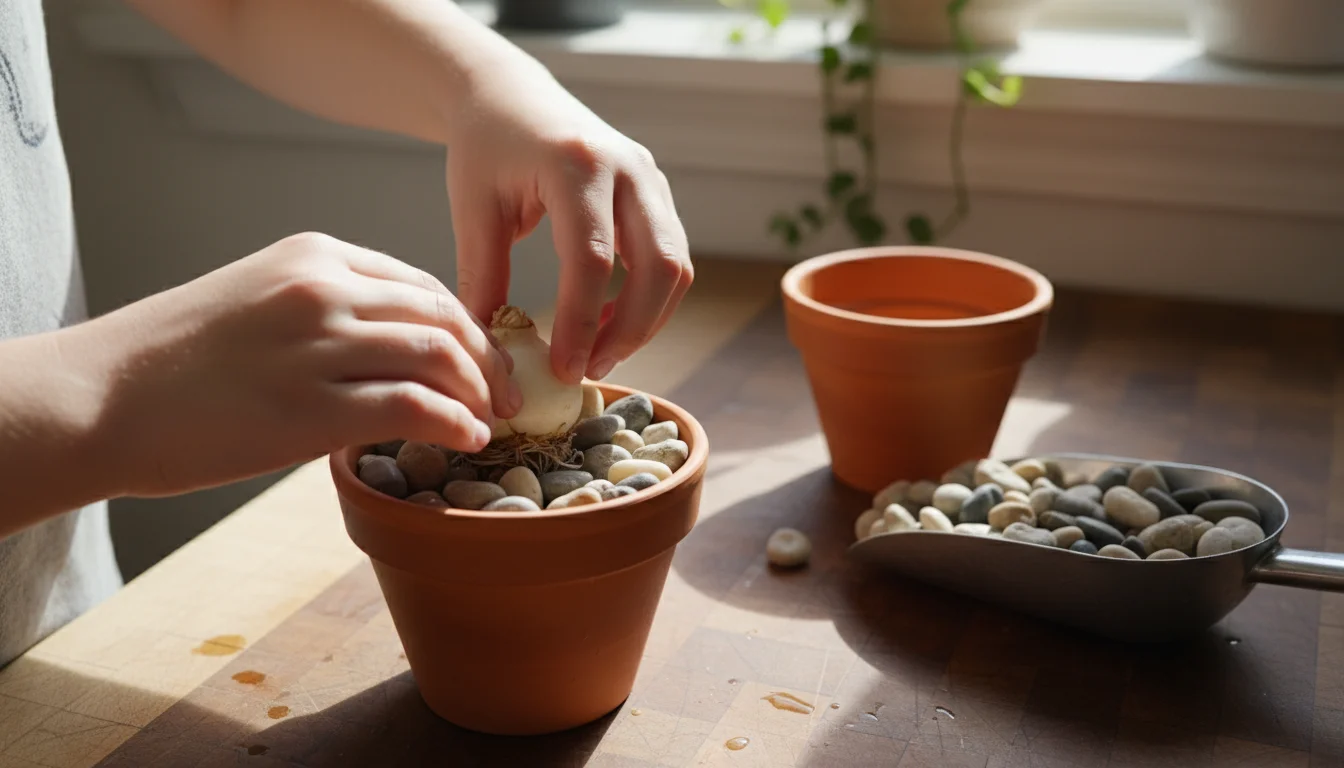


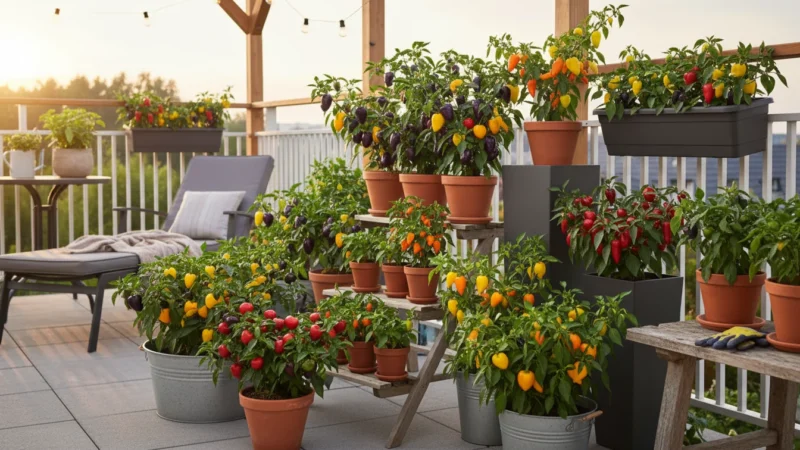
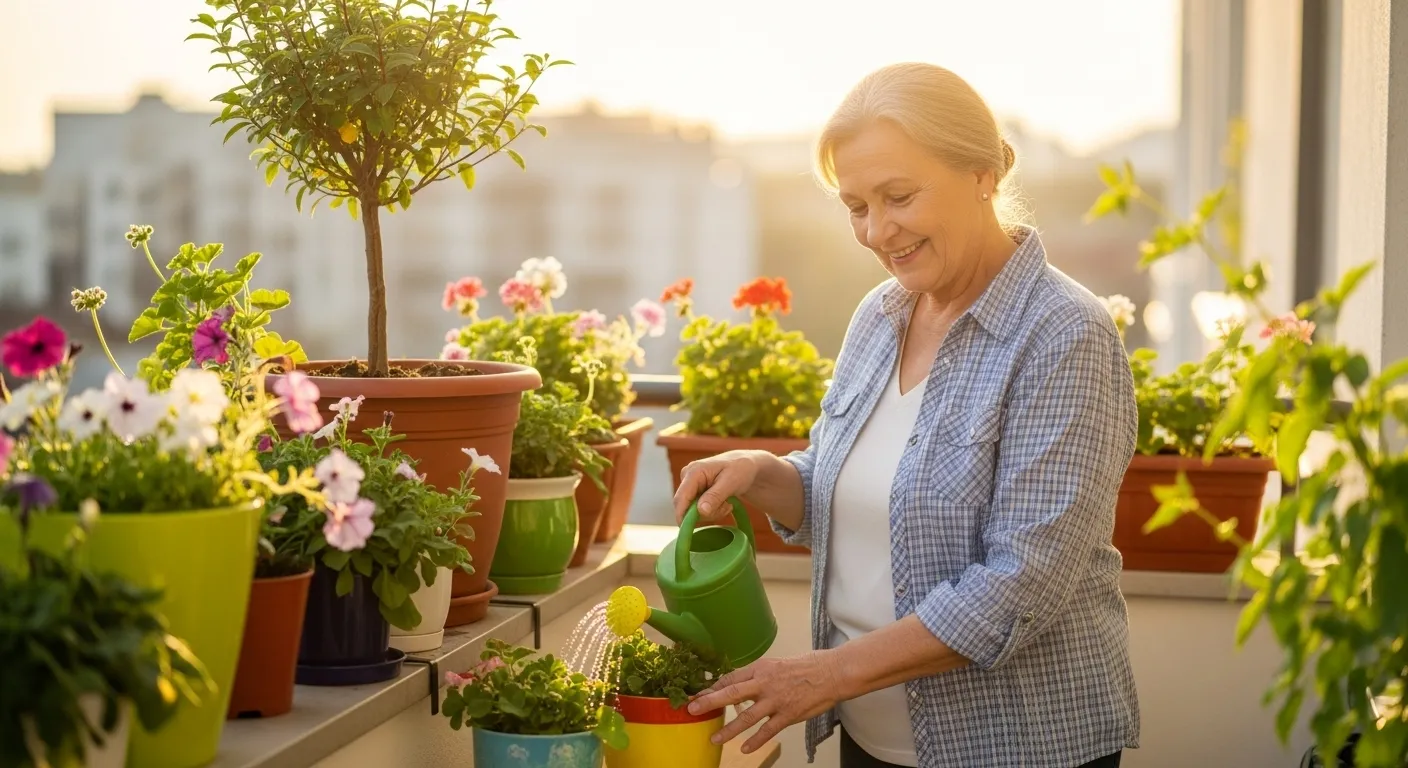
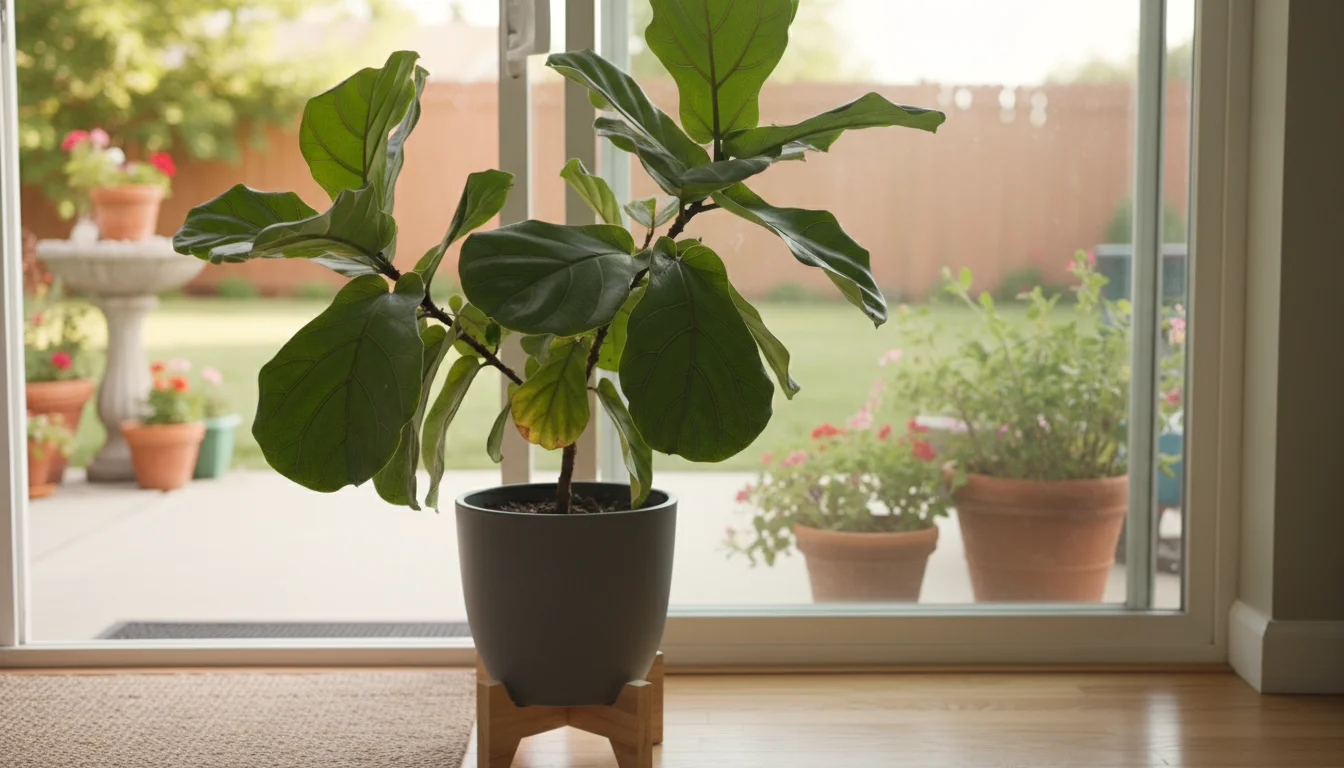
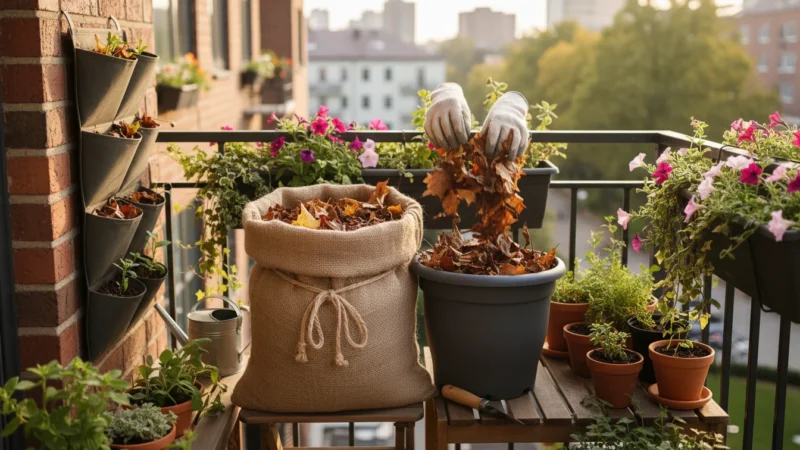
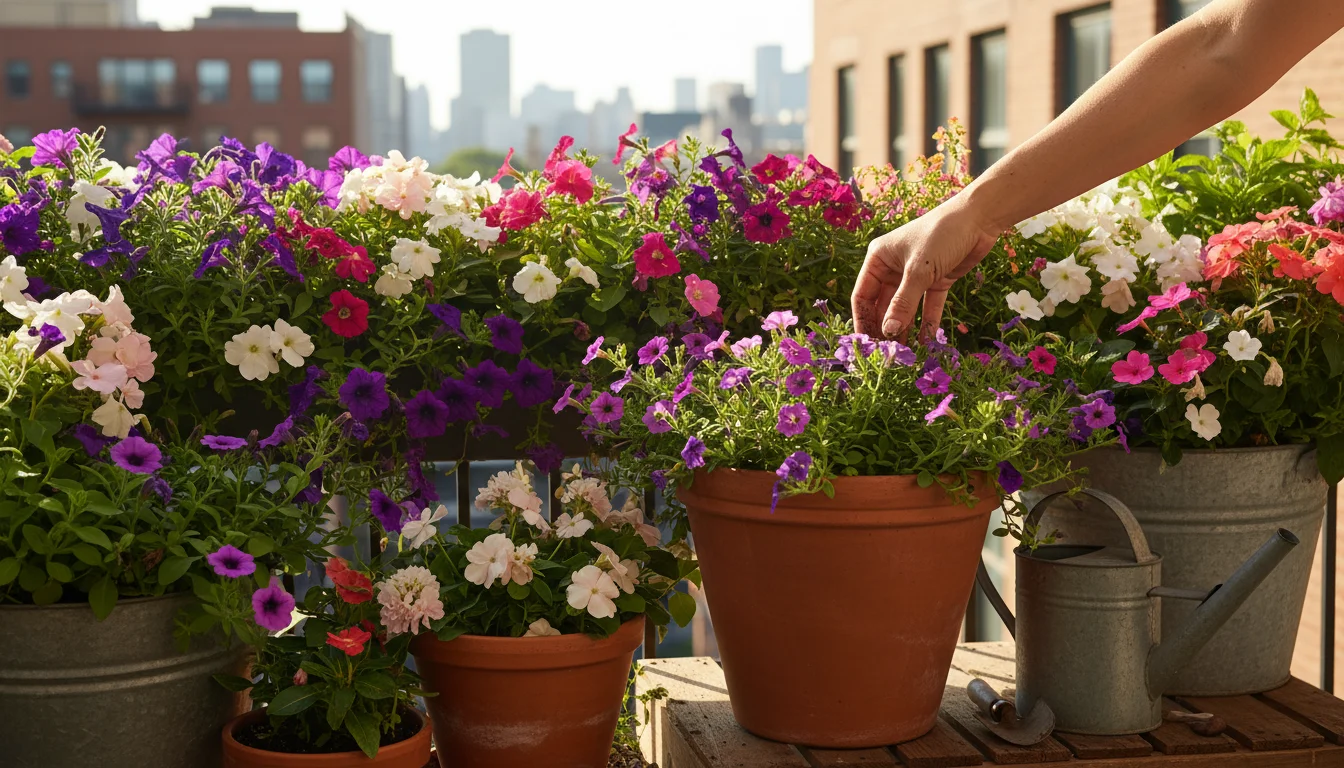

Leave a Reply